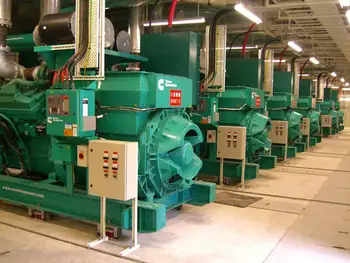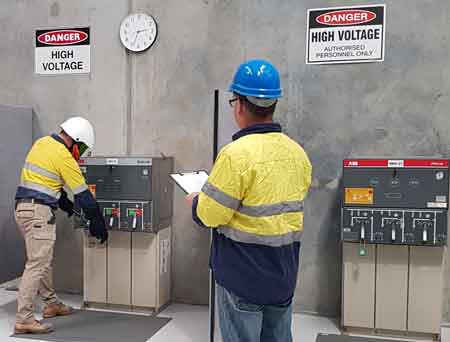How Does a Generator Work?
By R.W. Hurst, Editor
Emergency Generators & Standby Power Systems
Our customized live online or in‑person group training can be delivered to your staff at your location.

- Live Online
- 12 hours Instructor-led
- Group Training Available
Download Our NFPA 70E Fact Sheet – 2024 Electrical Safety Edition

- Understand how NFPA 70E works with NEC and NFPA 70B standards
- Clarify the shared responsibility between employers and employees
- Learn how NFPA 70E supports OSHA compliance
A generator works by using electromagnetic induction to convert mechanical energy into electricity. A rotor spins inside a stator, creating current, while a voltage regulator ensures stable output for homes, businesses, and industrial use.
How Does a Generator Work?
A generator is a device that converts mechanical energy into electrical energy.
? An engine or turbine provides the mechanical energy to rotate the rotor.
? The rotor spins inside the stator, creating a changing magnetic field that induces electrical current.
? The generated alternating current is regulated and delivered for residential, commercial, or industrial use.
Emergency Generator Standby Power Training
Power Quality Analysis Training
Request a Free Emergency Generator Training Quotation
A generator is widely used to provide electricity in various settings, from powering homes and businesses during power outages to supplying electricity to remote areas not connected to the power grid. In this article, we will delve into how a generator works and explain the various components of generating electricity using the keywords you provided.
It owes its invention to scientist Michael Faraday. Our article on emergency power supply explains how these systems provide seamless transitions during utility failures.
The principle of electromagnetic induction is the foundation of how it works. This principle states that a changing magnetic field can induce an electric current in a conductor. For example, a generator uses a rotating magnetic field to induce an electric current in a wire. The wire is wound around a stationary component called the stator, which contains the electrical conductor that converts the rotating magnetic field into electrical output. Our guide on emergency backup generators explains how these systems keep critical loads running during outages.
FREE EF Electrical Training Catalog
Download our FREE Electrical Training Catalog and explore a full range of expert-led electrical training courses.

- Live online and in-person courses available
- Real-time instruction with Q&A from industry experts
- Flexible scheduling for your convenience
Key Components and Their Functions
The rotor and stator are two of the essential components. The rotor is the rotating component, containing the magnets that produce the rotating magnetic field. The stator is the stationary component, having the electrical conductor that converts the rotating magnetic field into electrical output. The armature is the electrical conductor wound around the stator and produces the electrical output. It is usually made of copper or aluminum wire.
They can produce both AC and DC current. AC portable generators are the most common type used in most applications. They produce alternating current, meaning the current direction alternates periodically. In contrast, DC generators produce direct current, which flows in only one direction. They are used in specialized applications such as electric motors.
How Power is Generated and Regulated
The power output is determined by the magnetic field's strength and the rotor's speed. The stronger the magnetic field and the faster the rotor rotates, the higher the power output. The power output is usually measured in watts or kilowatts.
Fuel combustion is another crucial aspect of how generators work. Most are powered by internal combustion engines that burn gasoline, diesel, or natural gas. The engine drives the rotor, producing the rotating magnetic field that induces the electric current in the wire.
A voltage regulator is a component that controls the output voltage. It ensures that the voltage output remains constant even when the load on the device changes. This is important to prevent damage to electrical equipment connected to the unit.
The stator and rotor are the most crucial components, and they work together to generate electrical energy. The stator contains the electrical conductor that converts the rotating magnetic field into electrical output, and the rotor produces the magnetic field. The rotor rotates at high speed, generating a magnetic field that interacts with the stationary electrical conductor in the stator. The magnetic field induces an electric current in the wire, which generates an electrical output. Discover how an automatic transfer switch ensures seamless transitions between utility and electrical power.
Comparison of AC and DC Generator Technology
| Feature | AC Generator (Alternator) | DC Generator |
|---|---|---|
| Output Type | Alternating current (direction changes periodically) | Direct current (flows in one direction) |
| Common Use Cases | Homes, businesses, industrial applications, grid supply | Electric motors, battery charging, specialized equipment |
| Voltage Regulation | Typically uses automatic voltage regulators | Often uses commutators and brushes for output control |
| Efficiency | High efficiency at varying loads | Can be less efficient at high loads due to mechanical losses |
| Maintenance | Lower (no commutator brushes in most designs) | Higher (brushes and commutators wear over time) |
| Transmission | Suitable for long-distance power transmission | Less suitable for long-distance transmission |
| Cost | Generally lower for large-scale power generation | Generally higher for equivalent capacity |
| Durability | Longer service life with less mechanical wear | Shorter service life without regular maintenance |
Applications and Variations
Alternators are another type that is commonly used in vehicles. They are similar to AC generators but are designed to produce more power at lower speeds. Alternators are widely used in cars, trucks, and other vehicles to power the electrical system. Learn how different battery backup systems work to keep critical loads powered during outages. Learn how long battery backups last and what factors affect their reliability.
Generators are crucial devices that convert mechanical energy into electrical energy. They operate on the principle of electromagnetic induction and comprise several components, including the stator, rotor, armature, voltage regulator, and fuel combustion system. They can produce both AC and DC and are used in various applications. Understanding how generators work is essential for anyone who relies on electrical power. With this knowledge, you can appreciate the engineering behind these devices and make informed decisions about the best type for your needs. For a deeper look into reliable backup power solutions, check out our section on emergency backup generators.
Frequently Asked Questions
How does a generator work when the power goes out?
When utility power fails, a generator’s engine drives a rotor, creating a rotating magnetic field. This induces current in the stator windings, producing electricity. A voltage regulator maintains a stable output to protect connected equipment.
How does a generator work when it converts mechanical energy into electricity?
It uses electromagnetic induction, in which a rotating magnetic field induces current in the stator windings. Output depends on the rotor’s speed and the magnetic field’s strength.
What are the components of a generator?
Key parts include the rotor (which creates the magnetic field), the stator (which houses the conductors for output), the armature (wire windings), the voltage regulator, and the fuel system, which powers the engine that drives the rotor.
Sign Up for Electricity Forum’s Generators/UPS Newsletter
Stay informed with our FREE Generators/UPS Newsletter — get the latest news, breakthrough technologies, and expert insights, delivered straight to your inbox.
How does a generator maintain constant voltage?
A voltage regulator senses the output and adjusts rotor excitation to keep voltage steady, preventing damage to connected devices.
What is the difference between an AC and a DC generator?
AC generators produce alternating current with direction changes, common in most applications. DC generators produce one-way current for specialized uses like electric motors.
How does electromagnetic induction produce electrical energy?
When a conductor is in a changing magnetic field, current is induced. In generators, the rotor’s magnetic field interacts with the stator’s windings to create electricity.
How does a rotating magnetic field create electricity?
A rotor’s magnets spin, generating a magnetic field that passes through stationary stator windings. This induces current, with output based on magnetic strength and rotor speed.
Related Articles







